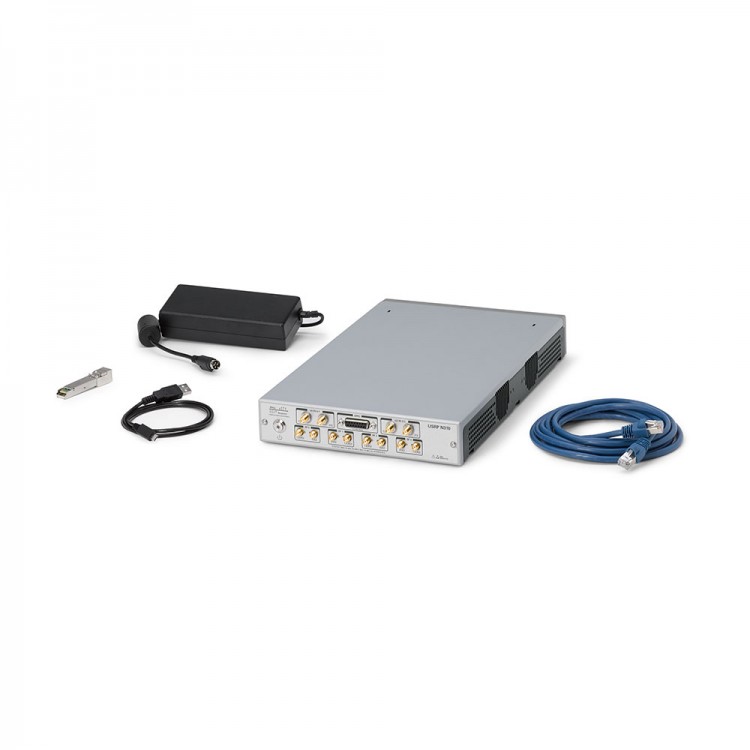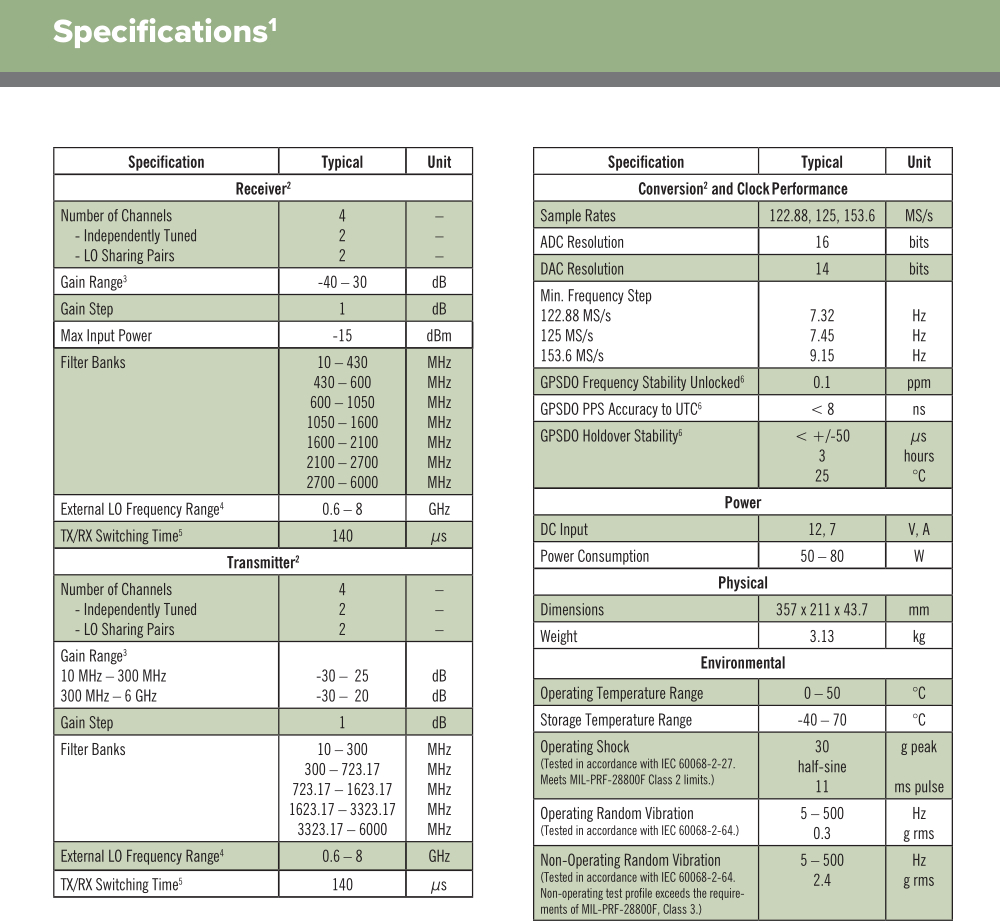
| Quantity | 3+ units | 10+ units | 30+ units | 50+ units | More |
|---|---|---|---|---|---|
| Price /Unit | $21,921.21 | $21,473.84 | $20,802.78 | $19,908.04 | Contact US |
Original USRP N310 Standard 10MHZ-6GHZ Networked SDR (ZYNQ-7100 4 Channels & 10 GIGE) for NI ETTUS
Overview:
The USRP N310 is a networked software defined radio (SDR) that provides reliability and fault-tolerance for deployment in large-scale and distributed wireless systems. The USRP N310 device simplifies control and management of a network of radios by introducing the unique capability to remotely perform tasks such as updating software, rebooting, factory resetting, self-testing, host PC/ARM debugging and monitoring system health.
The USRP N310 is one of the highest channel density devices in the SDR market, offering four RX and four TX channels in a half-wide RU form factor. The RF front end uses two AD9371 transceivers, the latest RFIC technology. Each channel provides up to 100 MHz of instantaneous bandwidth and covers an extended frequency range from 10 MHz to 6 GHz.
The open-source USRP Hardware Driver (UHD) API and RF Network-on-Chip (RFNoC) FPGA development framework reduce software development effort and integrate with a variety of industry-standard tools such as GNU Radio. Users can rapidly prototype and reliably deploy designs for a variety of SDR applications such as wireless test-beds, remote radio heads, spectrum monitoring, and more. Please note that the USRP N310 is not designed for fast tuning.
Baseband Processor
The baseband processor uses the Zynq-7100 SoC to deliver a large user-programmable FPGA for real-time and low-latency processing and a dual-core CPU (for ARM) for stand-alone operation. Users can deploy applications directly on to the preinstalled embedded Linux operating system or stream samples to a host computer using high-speed interfaces such as 1 Gigabit Ethernet, 10 Gigabit Ethernet, and Aurora over two SFP+ ports.
Synchronization
The USRP N310 has a flexible synchronization architecture with support for traditional SDR synchronization methods such as clock reference, PPS time reference, and GPSDO, which enable implementation of high channel count MIMO systems. In addition, the USRP N310 uniquely features Ethernet-based synchronization using the open-source White Rabbit timing protocol. White Rabbit enables precise baseband synchronization over large distances in GPS-denied environments.
Trusted Platform Module (TPM)
The USRP N310 includes a Trusted Platform Module to enable security features such as file encryption. Due to product compliance restrictions on products with TPM (Trusted Platform Module) components to a few countries, the USRP N310 is available in two variants:
• Standard variant with TPM (PN 785067-01)
• Non-TPM variant (PN 786465-01)
Only the non-TPM variant of the USRP N310 will be available in the People's Republic of China and Hong Kong. USRP N310 with TPM will not be available in France, Israel or Russia until the N310 is registered in those countries.
Features:
• High channel density
• Reliable and fault-tolerant deployment
• Remote management capability
• Stand-alone (embedded) or host-based (network streaming) operation
• Fully integrated and assembled (the USRP N310 does not support swappable daughtercards)
• 10 MHz to 6 GHz extended frequency range
• Up to 100 MHz of instantaneous bandwidth per channel
• 4 RX, 4TX in half-wide RU form factor[1]
• RX, TX filter bank
• 16 bit ADC, 14 bit DAC
• Configurable sample rates: 122.88, 125, and 153.6 MS/s
• Zynq-7100 SoC
• Dual-core Cortex-A9 800 MHz CPU for ARM
• Two SFP+ ports (1 Gigabit Ethernet, 10 Gigabit Ethernet, Aurora)
• RJ45 (1 GbE) [2]
• Clock reference
• PPS time reference
• External RX, TX LO input ports [3]
• Built-in GPSDO
• 1 Type A USB host port
• 1 micro-USB port (serial console, JTAG)
• Trusted Platform Module v1.2 [4]
• Watchdog timer
• For OpenEmbedded Linux
• USRP Hardware Driver™ (UHD) open-source software API version 3.11.0 or later
• RF Network on Chip (RFNoC™) FPGA development framework
• For Vivado 2017.4 Design Suite (license not included)
• GNU Radio support maintained through GR-UHD, an interface to UHD distributed by GNU Radio
[1] The RF front-end uses two AD9371 transceivers that are independently tunable. Each transceiver is capable of 2X2 MIMO operation with LO sharing between each channel.
[2] The RJ45 port is used for remote management of the device and does not support IQ streaming.
[3] The external LO frequency must be twice the center frequency, with center frequency limited to the range from 300 MHz to 4 GHz. Phase coherency is not repeatable after retune or reinitialization of the RF front-end. Phase recalibration is required after these operations.
[4] Due to product compliance restrictions on products with TPM (Trusted Platform Module) components to a few countries, the USRP N310 is available in two variants:
• Standard variant with TPM (PN 785067-01)
• Non-TPM variant (PN 786465-01)
Customers in the following regions should select the non-TPM option (PN 786465-01) listed above: People's Republic of China, Hong Kong, Russia, France, and Israel.
Package Included:
• 1 x USRP N310
• 1 x RJ45 Ethernet Cable
• 1 x SFP+ to RJ45 Adapter
• 1 x Micro-USB Cable
• 1 x Imaged microSD Card
• 1 x Power Supply
Packaging Details:
• Weight: 1kg
Recommended Accessories:
• 10 Gigabit Ethernet Card for Desktops
• 10 Gigabit Ethernet Cable with SFP+ termination
• Octoclock CDA-2990
• GPIO Expansion Kit
• 3V Active GPS Antenna
1 All specifications are subject to change without notice. This equipment information is only for product description and is not covered by warranty. Characteristic specifications are unwarranted values that are representative of an average unit operating at room temperature.
2 Additional transceiver and converter specifications can be found on the AD9371 data sheet. Link for http://www.analog.com/media/en/technical-documentation/data-sheets/AD9371.pdf
3 RX and TX path gain does not correlate to UHD gain settings. The received signal amplitude and output power resulting from the gain setting varies over the frequency band and among devices.
4 When using external LO sources, the operating frequency range is limited to 300 MHz to 4 GHz. The external LO frequency must be twice the operating frequency. Phase coherency is not repeatable after retune or reinitialization of the RF front-end. Phase recalibration is required after these operations.
5 Switching time is based on non-deterministic software control of the AD9371 transceiver. UHD modifications will be made to directly control the switch component at the TX/RX ports for faster performance.
6 Clock and timing specifications are based on information from component vendors and are not measured. Visit the USRP N310 hardware resources page: https://kb.ettus.com/N300/N310

